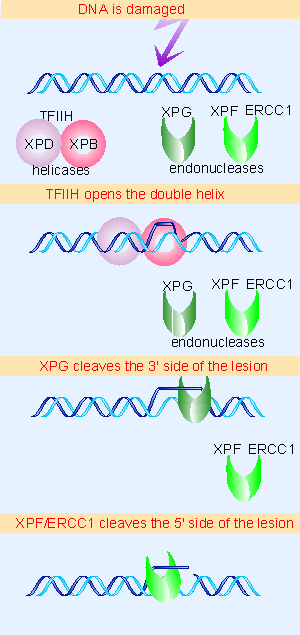18. Eukaryotic repair systems
14.18 Eukaryotic repair systems |
Biochemical characterization of repair systems in eukaryotic cells is less extensive. The existence of excision repair pathways can be established in cultured cells by following the actual removal of damage from DNA or by detecting the replacement of DNA segments in response to damaging treatments.
Genes involved in repair functions have been characterized genetically in yeast by virtue of their sensitivity to radiation. They are called RAD genes. There are three general groups of repair genes in yeast, identified by the RAD3 group (involved in excision repair), the RAD6 group (required for post-replication repair), and the RAD52 group (concerned with recombination-like mechanisms).
A superfamily of DNA polymerases involved in synthesizing DNA to replace material at damaged sites is identified by the dinB and umuCD genes that code for DNA polymerases IV and V in E. coli, and the rad30 gene coding for DNA polymerase η of S. cerevisiae. A difference between the bacterial and yeast enzymes is that the yeast DNA polymerase is not error-prone: it accurately introduces an A-A pair opposite a T-T dimer (Johnson, Prakash, and Prakash, 1999; for review see Goodman and Tippin, 2000; Friedberg, Feaver, and Gerlach, 2000).
An interesting feature of repair that has been best characterized in yeast is its connection with transcription. Transcriptionally active genes are preferentially repaired. The consequence is that the transcribed strand is preferentially repaired (removing the impediment to transcription). The cause appears to be a mechanistic connection between the repair apparatus and RNA polymerase. The RAD3 protein, which is a helicase required for the incision step, is a component of a transcription factor associated with RNA polymerase. This is discussed in 20.9 A connection between transcription and repair.
Mammalian cells show heterogeneity in the amount of DNA resynthesized at each lesion after damage. However, the longest patches seen in mammalian cells are comparable to those of the short-patch bacterial repair system. This pathway operates on damage caused by ultraviolet irradiation or by treatments that have related effects. Another pathway introduces only 3 V4 repair bases at sites of damage generated by X-irradiation or alkylation.
An indication of the existence and importance of the mammalian repair systems is given by certain human hereditary disorders. The best investigated of these is xeroderma pigmentosum (XP), a recessive disease resulting in hypersensitivity to sunlight, in particular to ultraviolet. The deficiency results in skin disorders (and sometimes more severe defects).
 |
Figure 14.37 A helicase unwinds DNA at a damaged site, endonucleases cut on either side of the lesion, and new DNA is synthesized to replace the excised stretch. Animated figure |
The disease is explicable in terms of a failing in excision repair; fibroblasts from XP patients are deficient in the excision of pyrimidine dimers and other bulky adducts. Several (~9) genetic complementation groups have been distinguished, many characterized by a deficiency at the incision step of repair. Six of the genes identifying individual XP loci have been cloned, and each has a counterpart in yeast. Six of the 11 loci in the group that includes RAD3 are homologs of XP genes, suggesting extensive conservation of this excision repair pathway. Several of the XP products are components of the factor TFIIH, which is involved with the repair of damaged DNA that is encountered by RNA polymerase during transcription. Figure 14.37 shows its role in this repair pathway. The XPV gene is the human homolog of yeast rad30. Skin cancers that occur in XPV mutants are presumably due to loss of the DNA polymerase η activity that enables replication to occur accurately in spite of T-T dimers.
Double-strand breaks occur in cells in various circumstances. They initiate the process of homologous recombination and are an intermediate in the recombination of immunoglobulin genes (see 24 Immune diversity). They also occur as the result of damage to DNA, for example, by irradiation. The major mechanism to repair these breaks is called non-homologous end joining (NHEJ), and consists of ligating the blunt ends together. The same enzyme complex undertakes the process in both NHEJ and immune recombination. It consists of the proteins Ku70 and Ku80, which form a dimer that binds the DNA double-stranded end, the DNA Vdependent protein kinase (DNA VPKcs), and the DNA ligase IV, which functions in conjunction with the protein XRCC4. Mutations in any of these components may render eukaryotic cells more sensitive to radiation. Some of the genes for these proteins are mutated in patients who have diseases due to deficiencies in DNA repair.
Some indirect results suggest that mammalian cells have recombination-repair systems. Again, these systems may be related to genetic recombination itself. An example is the recessive human disorder of Bloom’s syndrome; an increased frequency of chromosomal aberrations, including sister chromatid exchanges, could be related to the operation of recombination systems.
This section updated 9-27-2000
| Reviews | |
| Goodman, M. F. and Tippin, B. (2000). Sloppier copier DNA polymerases involved in genome repair.. Curr. Biol. 10, 162-168. | |
| Research | |
| Friedberg, E. C. , Feaver, W. J. , and Gerlach, V. L. (2000). The many faces of DNA polymerases: strategies for mutagenesis and for mutational avoidance. Proc. Nat. Acad. Sci. USA 97, 5681-5683. | |
| Johnson, R. E. , Prakash, S. , and Prakash, L. (1999). Efficient bypass of a thymine-thymine dimer by yeast DNA polymerase, Pol eta.. Science 283, 1001-1004. | |